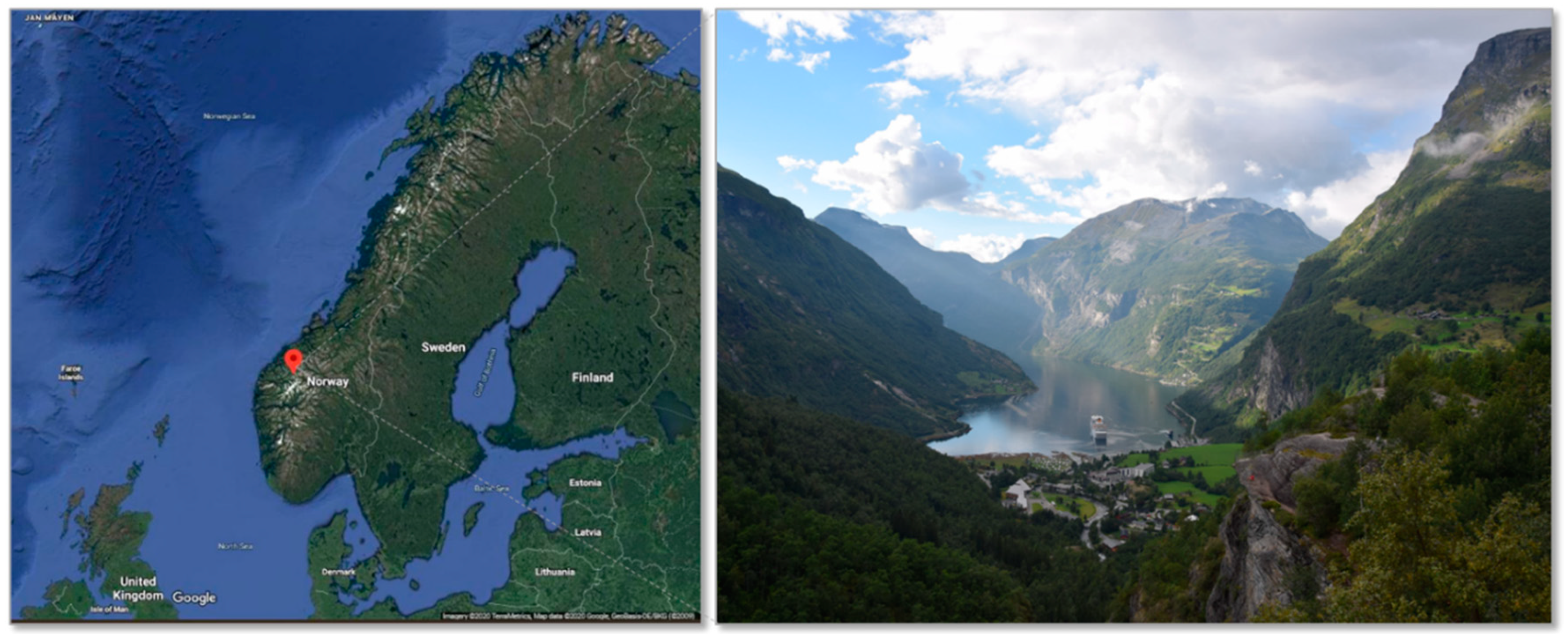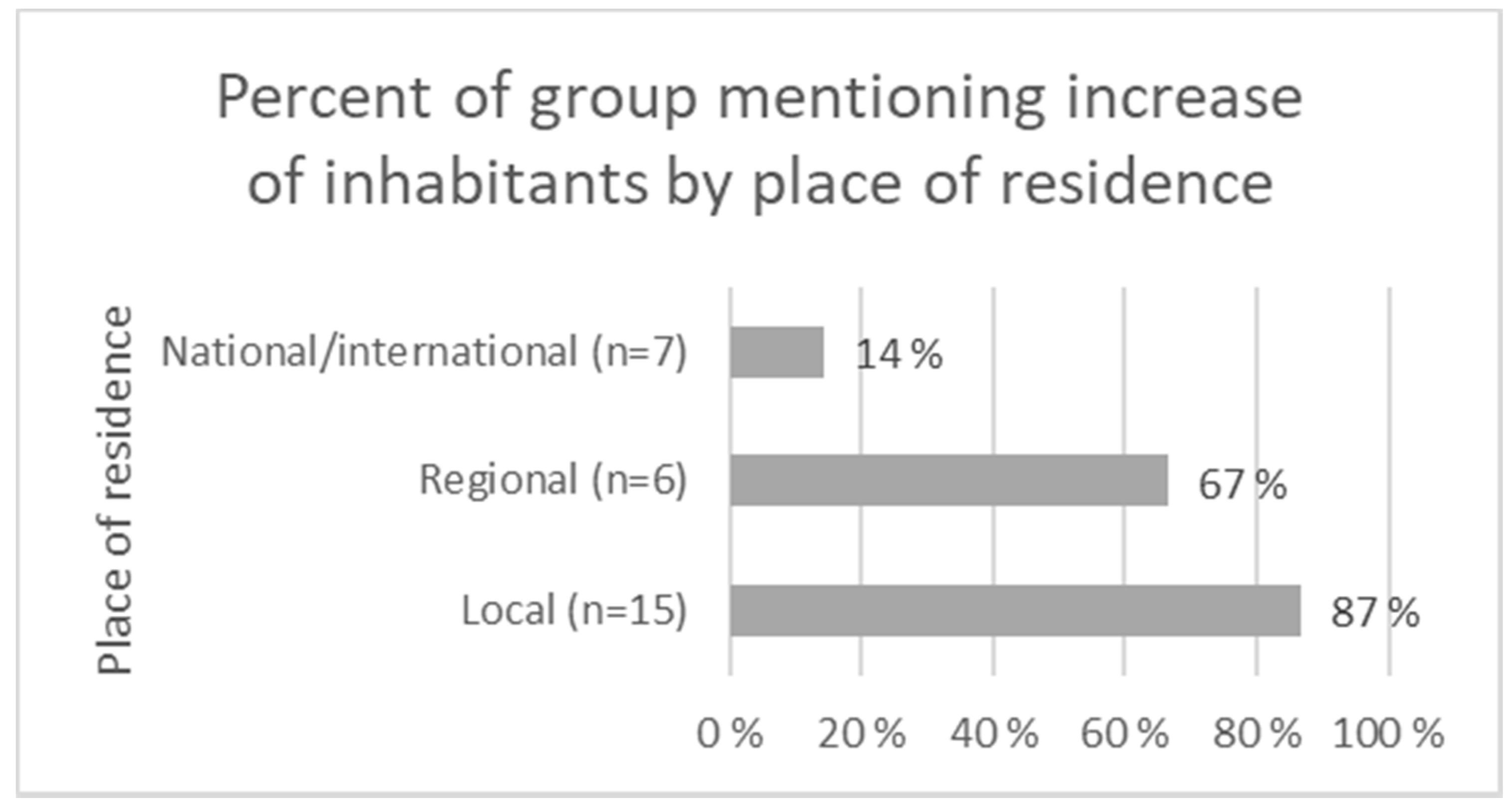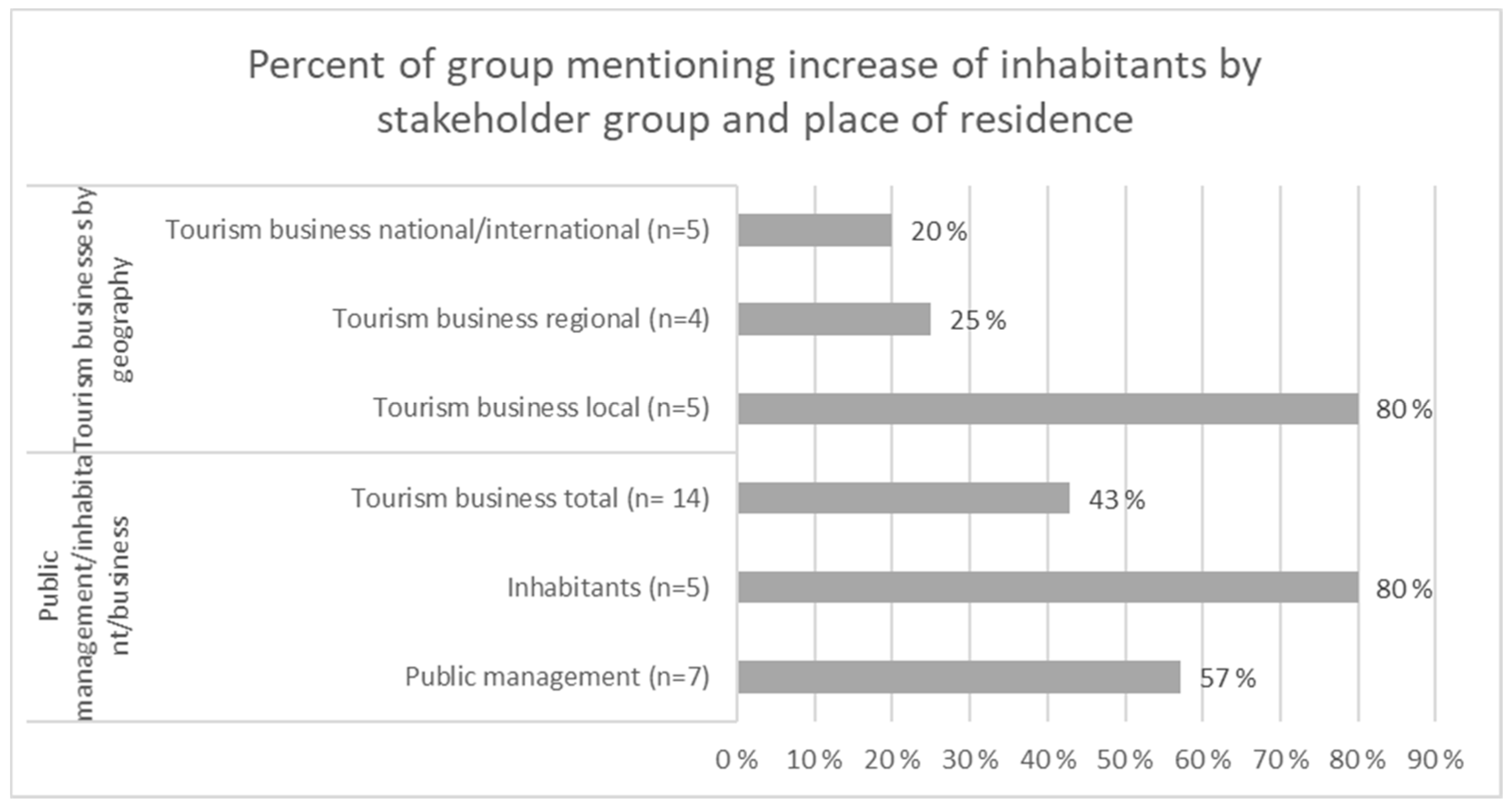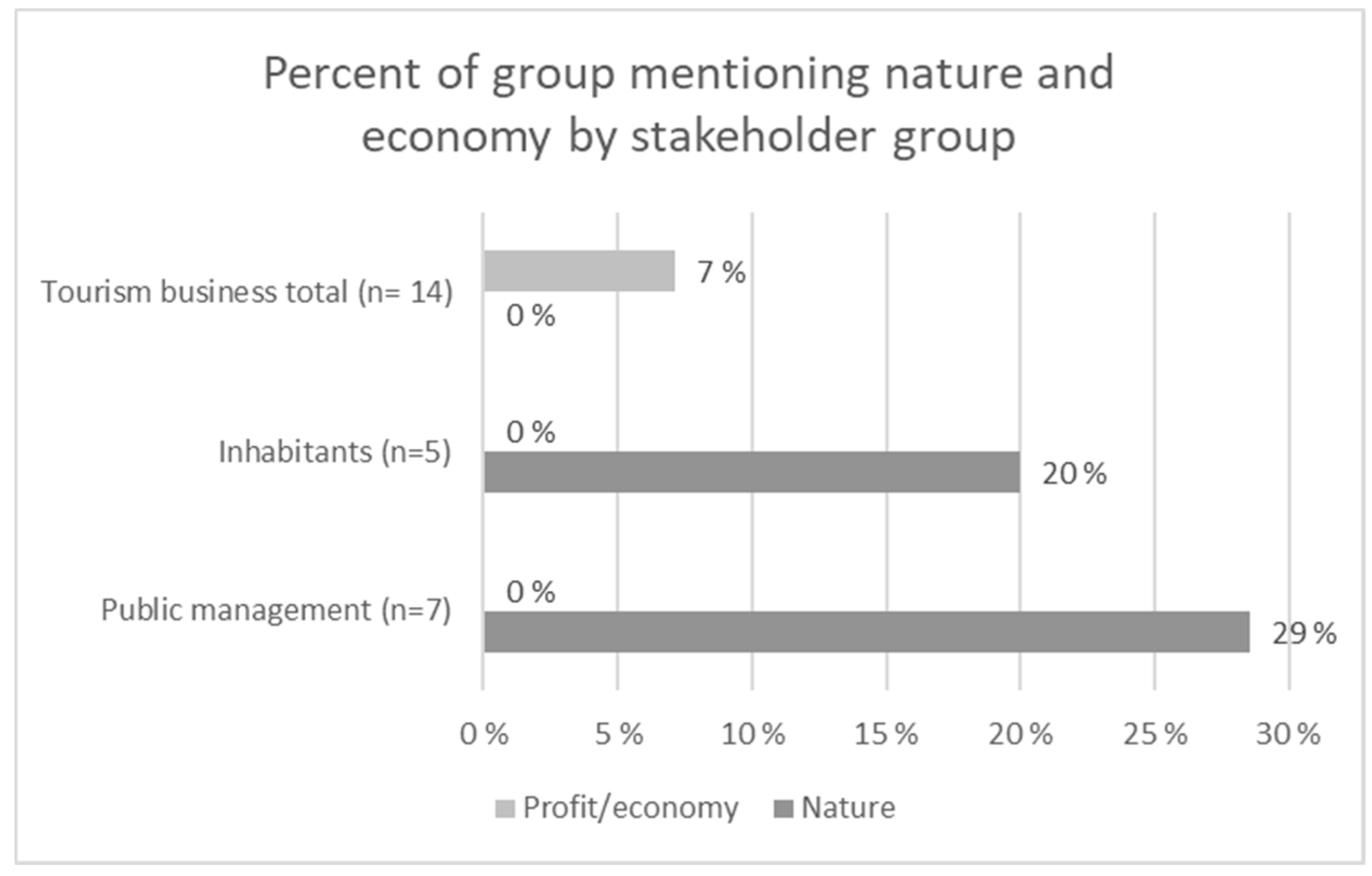Perception of Sustainable Development in a Local World Heritage Perspective
Abstract
1. Introduction
2. Literature Review
“1. Sustainable development is development that meets the needs of the present without compromising the ability of future generations to meet their own needs. It contains two key concepts:
2.1. Perceptions
2.2. Perceptions of Sustainable Development
2.3. Environmental Beliefs, Attitudes and Values—And Sustainable Behavior
3. Materials and Methods
3.1. Study Area
3.2. Data Collection
3.3. Data Analysis
4. Results
4.1. Main Themes
4.1.1. Increase in the Number of Inhabitants in the Community
“We want people to live here, have children in school and kindergarten. This is important for the future. We are almost down to 20 kids from 1st to 10th grade here (in school). (The problem is)… the municipality, finances, no residential plots... When people are not able to build houses, they move, there are no houses for sale, they are inherited by (outside) relatives.” (Interview with local businessperson, own addition in brackets)
“I am not happy about those who are here three to four months, and do not have residential addresses in Geiranger or Stranda municipality… So be it, but the social part is absent. We just see them passing by, none of them contribute to (social activities like) skiing, bazaars or choirs. The biggest challenge (related to sustainability) is people. There is nothing wrong with those “surfing” and making money only in summer, but maybe they should stay half of the year… How can we develop an area or village when we’re only 200 inhabitants?” (Local resident and businessperson, own addition in brackets)
“Geiranger 2030The overriding goal is to create a vibrant local community through sustainable year-round tourism.” [69]
“There may be too much traffic in July. There is an incredible interest during the Norwegian holiday weeks. There are huge contrasts between 20 July and 1 October. Everyone wants to spread the traffic, but people have holidays in summer…. The whole village loses money from 1 October to 1 May. If we fail to make money during summer so that we can keep the businesses open in winter, the snowball will roll the wrong way. Now we earn reasonably well in summer, because of this we can keep open in winter. Accountants ask why we do not just close in winter, but we want the village to be alive all year round. We will continue to try, it is a goal for us living here.” (Interview with a local resident and businessperson.)
4.1.2. Traffic
“I would think that, for example, for cruise lines to survive in the future they must change to more environmentally friendly ways. They (Geiranger) may have to get a new cruise quay in the long run. Remote parking (one of the solutions discussed) is not possible, I do not believe in it, the cars must be able to drive through here. If there was a tunnel (…), we could then have electric buses so that people could drive down here. I do not envision now that we can start with remote parking. If you are going to (drive) through and you cannot park in the valley... (It is) not a simple question. There will probably be more electric cars eventually … we do not have a charging station in the center, (then the visitor) must drive to the Fjord Center to charge a car. I am thinking that Geiranger cannot pioneer everything, we are so few inhabitants here, all inhabitants here are needed.“ (Local resident and businessperson, own addition in brackets.)
“.. reduce the number of tourists during the peak summer months and spread tourism throughout the year—at least spring and autumn season.” (Interview with local inhabitant and businessperson.)
“I am thinking that if we had been clever enough to get tourists all year, especially during the shoulder season... that focus on mass tourism was not so strong, that we had a better product for the individual travelers….” (Interview with local inhabitant and businessperson.)
4.2. Emergent Patterns
4.2.1. An Anthropocentric Worldview
“Interviewer: Would you say that you and/or your organization have interests related to how the natural environment develops in the Geirangerfjord and surrounding areas?Interviewee: I’d say that’s what they (tourism enterprises) live from.Interviewer: In what way?Interviewee: …. people come here to experience the area, silence, tranquility, the same as in 1886, it is the main reason why people travel from home and spend a lot of money…“ (Interview with public official related to Geiranger. Own addition in brackets)
“ I think I would rank environmental challenges as number one, and by this I mean both on land and in the fjord, because it creates these images of Geiranger, this with the blue smog—that we are approaching a level of pollution that is harmful to health. Then preserving the cultural landscape as number two, it is dependent on farmers who cultivate the land. ... So, one, the environment, two, the cultural landscape.” (Interview with public official related to Geiranger area.)
“When tourists write letters on their own ... (about crowding/air pollution) ... we live after all off the market, (then we) must do something. We have received NOK 2 million to develop a master plan for Geiranger to preserve world heritage, nature and cultural qualities.” (Interview with public official related to the Geiranger area. Own addition in brackets)
“The ship calls also periodically cause aesthetic pollution consisting of visible clouds consisting of particles, NOx, sulfur oxides (SOx) and water vapor.” [70]
“The starkly dramatic landscapes of Geirangerfjord and Nærøyfjord are exceptional in scale and grandeur in a country of spectacular fjords….». [71]
4.2.2. The Interconnectedness of Issues—With Settlement as the Endpoint
“Hm, I do not know …. where you can leave as few traces as possible, but at the same time have a basis for thriving and living” (Interview with public official and regional resident.)
“Tourism = business = making a living and developing the community. 600—1000 inhabitants (as a goal).” (Questionnaire answer in writing from local resident and businessperson. Own addition in brackets.)
“(Sustainability is…) 1. Year-round tourism, year-round workplaces. 2. Opportunity to find a place to live—to have access to labor, to be able to run the business all year. Then the rest will go by itself.” (Interview with regional official. Own addition in brackets.)“... Want it to be financially sustainable for businesses, while still taking care of natural qualities. That Geiranger as a community still has a social life. All year round jobs.” (Interview with regional resident and official.)
“To reduce the number of tourists in the peak of summer, spread visitation throughout the year, at least spring and autumn season... Creating the basis for a larger proportion of year-round residence that can provide a “caretaker company”—locals who can take care of what is necessary to take care of in the area. “ (Interview with local resident and businessperson.)
4.3. WINT Analysis—What Is Not There
“The financial results have to be positive. Most preferably positive enough to expand (business). If we are unable to have positive financial results, most things will stop by themselves.” (Interview with business representative. Own addition in brackets.)
4.4. Comparison across Groups
“(Sustainability entails…) the solutions that first and foremost take care of the natural environment, that must be my role, I am less concerned if (the solutions are) financially sustainable. This might have been different if I was answering as a private person….” (Interview with public representative. Own addition in brackets.)
5. Discussion
6. Conclusions
Author Contributions
Funding
Acknowledgments
Conflicts of Interest
References
- United Nations. Report of the World Commission on Environment and Development: Our Common Future; United Nations: New York, NY, USA, 1987. [Google Scholar]
- Kruja, D.; Alkida, H. Comparisons of stakeholders’ perception towards the sustainable tourism development and its impacts in Shkodra Region (Albania). Turizam 2010, 14, 1–12. [Google Scholar] [CrossRef]
- Timur, S.; Getz, D. Sustainable tourism development: How do destination stakeholders perceive sustainable urban tourism? Sustain. Dev. 2009, 2009, 220–232. [Google Scholar] [CrossRef]
- Vermeulen, W.J.V. Substantiating the rough consensus on concept of sustainable development as point of departure for indicator development. In Routledge Handbook of Sustainability Indicators; Bell, S., Morse, S., Eds.; Routledge: Abingdon, UK, 2018. [Google Scholar]
- UNESCO. Policy Document for the Integration of a Sustainable Development Perspective into the Processes of the World Heritage Convention. In Proceedings of the General Assembly of States Parties to the World Heritage Convention, Paris, France, 18–20 November 2015. [Google Scholar]
- UN General Assembly. Transforming Our World: The 2030 Agenda for Sustainable Development; Res. 70/1; UN General Assembly: New York, NY, USA, 2015. [Google Scholar]
- Robinson, J. Squaring the circle? Some thoughts on the idea of sustainable development. Ecol. Econ. 2004, 48, 369–384. [Google Scholar] [CrossRef]
- Macnaghten, P.; Jacobs, M. Public identification with sustainable development. Investigating cultural barriers to participation. Glob. Environ. Change 1997, 7, 5–24. [Google Scholar] [CrossRef]
- Macnaghten, P.; Grove-White, R.; Jacobs, M.; Wynne, B. Public Perceptions and Sustainability in Lancashire: Indicators, Institutions, Participation; Lancashire County Council: Preston, UK, 1995. [Google Scholar]
- Lueg, C.P. Characteristics of human perception and their relevance when studying information behavior. J. Doc. 2014, 70, 562–574. [Google Scholar] [CrossRef]
- Greenwald, A.G.; Banaji, M.R. Implicit social cognition: Attitudes, self-esteem, and stereotypes. Psychol. Rev. 1995, 102, 4–27. [Google Scholar] [CrossRef]
- Parker, A.J.; Newsome, W.T. Sense and th single neuron: Probing the physiology of perception. Annu. Rev. Neurosci. 1998, 21, 227–277. [Google Scholar] [CrossRef]
- Freeman, W.J. The physiology of perception. Sci. Am. 1991, 264, 78–85. [Google Scholar] [CrossRef]
- Imran, S.; Alam, K.; Beaumont, N. Environmental orientations and environmental behaviour: Perceptions of protected area tourism stakeholders. Tour. Manag. 2014, 40, 290–299. [Google Scholar] [CrossRef]
- O’Toole, K.; Wallis, A.; Mitchell, B. Local perceptions of sustainability indicators: Issues of scale and implications for management. Rural Soc. 2014, 16, 25–46. [Google Scholar] [CrossRef]
- Labadi, S. UNESCO, World Heritage, and sustainable development: International discourses and local impacts. In Collision or Collaboration. Archaeology Encounters Economic Development; Gould, P.G., Pyburn, K.A., Eds.; Springer International Publishing: Cham, Switzerland, 2017; pp. 45–60. [Google Scholar] [CrossRef]
- McDonald, F.V. Developing an Integrated Conceptual Framework of Pro-Environmental Behavior in the Workplace through Synthesis of the Current Literature. Administrative Sci. 2014, 2014, 276–303. [Google Scholar] [CrossRef]
- Yttredal, E.R.; Babri, S.; Diez, M. Antall Besøkende og Kjøretøy i Geirangerområdet 2018; Notat—nr. 4/2019; Høgskulen i Volda: Volda, Norway, 2019. [Google Scholar]
- Mebratu, D. Sustainability and sustainable development: Historical and conceptual review. Environ. Impact Assess. Rev. 1998, 18, 493–520. [Google Scholar] [CrossRef]
- Lumley, S.; Armstrong, P. Some of the nineteenth century origins of the sustainability concept. Environ. Dev. Sustain. 2004, 2004, 367–378. [Google Scholar] [CrossRef]
- Heinberg, R. What Is Sustainability? Post Carbon Institute: Santa Rosa, CA, USA, 2010. [Google Scholar]
- Griggs, D.; Stafford-Smith, M.; Gaffney, O.; Rockström, J.; Öhman, M.C.; Shyamsundar, P.; Steffen, W.; Glaser, G.; Kanie, N.; Noble, I. Sustainable development goals for people and planet. Nature 2013, 495, 305–307. [Google Scholar] [CrossRef]
- Ciegis, R.; Ramanauskiene, J.; Martinkus, B. The Concept of Sustainable Development and its Use for Sustainability Scenarios. Inz. Ekon. Eng. Econ. 2009, 2009, 28–37. [Google Scholar]
- Steffen, W.; Richardson, K.; Rockström, J.; Cornell, S.E.; Fetzer, I.; Bennett, E.M.; Biggs, R.; Carpenter, S.R.; De Vries, W.; De Wit, C.A.; et al. Planetary boundaries: Guiding human development on a changing planet. Science 2015, 347. [Google Scholar] [CrossRef]
- Rockström, J.; Steffen, W.; Noone, K.; Persson, A.; Chapin Iii, F.S.; Lambin, E.; Lenton, T.M.; Scheffer, M.; Folke, C.; Schellnhuber, H.J.; et al. Planetary boundaries: Exploring the safe operating space for humanity. Ecol. Soc. 2009, 14. [Google Scholar] [CrossRef]
- Rockström, J.; Steffen, W.; Noone, K.; Persson, Å.; Chapin, F.S.; Lambin, E.F.; Lenton, T.M.; Cheffer, M.; Folke, C.; Institute of Arctic Biology University of Alaska Fairbanks; et al. A safe operating space for humanity. Nature 2009, 461, 472–475. [Google Scholar] [CrossRef] [PubMed]
- Aall, C. Sustainable Tourism in Practice: Promoting or Perverting the Quest for Sustainable Development? Sustainability 2014, 2014, 2562–2583. [Google Scholar] [CrossRef]
- APA Dictionary of Psychology. Perception. Available online: https://dictionary.apa.org/perception (accessed on 24 August 2020).
- Dunham, Y.; Banaji, M.R. Platonic blindness and the challenge of understanding context. In The Mind in Context; Mesquita, B., Feldman Barrett, L., Smith, E.R., Eds.; The Guilford Press: New York, NY, USA, 2010. [Google Scholar]
- Haidt, J. Chapter 53: The emotional dog and its rational tail: A social intuitionist approach to moral judgment. In Reasoning. Studies of Human Inference and its Foundations; Adler, J.E., Rips, L.J., Eds.; Cambridge University Press: Cambridge, UK, 2008. [Google Scholar]
- Michel, A. Cognition and Perception: Is There Really a Distinction. Available online: https://www.psychologicalscience.org/observer/cognition-and-perception-is-there-really-a-distinction (accessed on 24 August 2020).
- Tversky, A.; Kahneman, D. The framing of decisions and the psychology of choice. Science 1981, 211, 453–458. [Google Scholar] [CrossRef]
- Stangor, C.; Jhangiani, R.; Tarry, H. Principles of Social Psychology, 1st ed.; BCcampus OpenEd: Minneapolis, MN, USA, 2014; Available online: https://opentextbc.ca/socialpsychology/ (accessed on 20 August 2020).
- Erdelez, S. Investigation of intormation encountering in the controlled research environment. Inf. Process. Manag. 2004, 40, 1013–1025. [Google Scholar] [CrossRef]
- Mack, A. Inattentional blindness. Looking without seeing. Curr. Dir. Psychol. Sci. 2003, 12, 180–184. [Google Scholar] [CrossRef]
- Pearson, C.J. Sustainability: Perceptions of problems and progress of the paradigm. Int. J. Agric. Sustain. 2003, 1, 3–13. [Google Scholar] [CrossRef]
- Jones, N.; Malesoios, C.; Aloupi, M.; Priokaki, M.; Tsalis, T.; Hatziantoniou, M.; Dimitrakopoulos, P.G.; Skouloudis, A.; Holtvoeth, J.; Nikolaou, I.; et al. Exploring the role of local community perceptions in sustainability measurements. Int. J. Sustain. Dev. World Ecol. 2019, 26, 471–483. [Google Scholar] [CrossRef]
- Tiani, A.M.; Charnacle, J.-M.B. Simple criteria and indicators to uncover and negotiate local perceptions on sustainability. For. Trees Livelihoods 2007, 17, 3–21. [Google Scholar] [CrossRef]
- Törn, A.; Siikamäki, P.; Tolvanen, A.; Kaupplila, P.; Rämet, J. Local people, nature conservation and tourism in northeastern Finland. Ecol. Soc. 2008, 13, 8. [Google Scholar] [CrossRef]
- Campbell, S.J.; Kartawijaya, T.; Yulianto, I.; Prasetia, R.; Clifton, J. Co-management approahes and incentives improve management effectiveness in the Karimanjawa National Park, Indonesia. Mar. Policy 2013, 41, 72–79. [Google Scholar] [CrossRef]
- Novelli, M.; Scarth, A. Tourism in protected areas: Integrating conservation and community development in Liwonde National Park (Malawi). Tour. Hosp. Plan. Dev. 2007, 4, 47–73. [Google Scholar] [CrossRef]
- Sekhar, N.U. Local people’s attitudes towards conservation and wildlife tourism around Sariska Tiger Reserve, India. J. Environ. Manag. 2003, 69, 339–347. [Google Scholar] [CrossRef] [PubMed]
- Sirivongs, K.; Tsuchiya, T. Relationship between local residents’ perceptions, attitudes and participation towards national protected areas: A case study of Phou Khao Khouay National Protected Area, central Lao PDR. For. Policy Econ. 2012, 21, 92–100. [Google Scholar] [CrossRef]
- Stern, P.C. Toward a coherent theory of environmentally significant behavior. J. Soc. Issues 2000, 56, 407–424. [Google Scholar] [CrossRef]
- Stern, P.C.; Dietz, T. The value basis of environmental concern. J. Soc. Issues 1994, 50, 65–84. [Google Scholar] [CrossRef]
- Amérigo, M.; Aragonés, J.I.; Frutos, B.D.; Sevillano, V.; Cortés, B. Underlying dimensions of ecocentric and anthropocentric environmental beliefs. Span. J. Psychol. 2007, 10, 97–103. [Google Scholar] [CrossRef] [PubMed]
- Inkpen, R.; Baily, B. Environmental beliefs and their role in environmental behaviours of undergraduate students. J. Environ. Stud. Sci. 2020, 10, 57–67. [Google Scholar] [CrossRef]
- Juvan, E.; Donicar, S. The attitude-behaviour gap in sustainable tourism. Ann. Tour. Res. 2014, 48, 76–95. [Google Scholar] [CrossRef]
- Juvan, E.; Dolnicar, S. Measuring Environmentally Sustainable Tourist Behaviour. Ann. Tour. Res. 2016, 59, 30–44. [Google Scholar] [CrossRef]
- Arnberger, A.; Eder, R.; Allex, B.; Sterl, P.; Burns, R.C. Relationships between national-park affinity and attitudes towards protected area management of visitors to the Gesaeuse National Park, Austria. For. Policy Econ. 2012, 19, 48–55. [Google Scholar] [CrossRef]
- Carrus, G.; Bonaiuto, M.; Bonnes, M. Environmental concern, regional identity, and support for protected areas in Italy. Environ. Behav. 2005, 37, 237–257. [Google Scholar] [CrossRef]
- Davis, J.L.; Green, J.D.; Reed, A. Interdependence with the environment: Commitment, interconnectedness, and environmental behavior. J. Environ. Psychol. 2009, 29, 173–180. [Google Scholar] [CrossRef]
- Statistics Norway. 04317: Grunnkretsenes Befolkning (G) 1999–2019. Available online: https://www.ssb.no/statbank/table/04317/ (accessed on 12 September 2019).
- Löffler, J. Annual Scientific Report 2019; University of Bonn: Bonn, Germany, 2019. [Google Scholar]
- Löffler, J. Annual Scientific Report 2018; University of Bonn: Bonn, Germany, 2018. [Google Scholar]
- Löffler, J. Annual Scientific Report 2017; University of Bonn: Bonn, Germany, 2017. [Google Scholar]
- Löffler, J. Annual Scientific Report 2016; University of Bonn: Bonn, Germany, 2016. [Google Scholar]
- Sjøfartsdirektoratet. Utslipp til Luft og Sjø fra Skipsfart i Fjordområder med stor Cruisetrafikk; Sjøfartsdirektoratet: Haugesund, Norway, 2017. [Google Scholar]
- Lange, O.R. Ny turistrapport: Advarer mot livsfarlig sommerluft i den norske turistperlen. Dagbladet. Available online: https://www.dagbladet.no/tema/advarer-mot-livsfarlig-sommerluft-i-den-norske-turistperlen/69563089 (accessed on 3 March 2020).
- Lange, O.R. Cruiseverstingene dropper norske fjordperler etter dette. Dagbladet. Available online: https://www.dagbladet.no/tema/cruiseverstingene-dropper-norske-fjordperler-etter-dette/71391279 (accessed on 12 July 2019).
- Stortingsforhandlinger. Klimatrategi for 2030—Norsk Omstilling i Europeisk Samarbeid; Meld. St. 41.; Storting: Oslo, Norway, 2016–2017. [Google Scholar]
- Freeman, R.E. Strategic Management: A Stakeholder Approach; Pitman: Boston, MA, USA, 1984. [Google Scholar]
- Saldaña, J. The Coding Manual for Qualitative Researchers; SAGE: Thousand Oaks, CA, USA, 2016. [Google Scholar]
- Bhatia, V.; Flowerdew, J.; Jones, R.H. Approaches to Discourse Analysis. In Advances in Discourse Studies; Bhatia, V., Flowerdew, J., Jones, R.H., Eds.; Routledge: Abingdon, UK, 2008; pp. 1–17. [Google Scholar]
- Fairclough, N. Critical Discourse Analysis: The Critical Study of Language, 2nd ed.; Longman: Hanlow, NSW, Australia, 2010. [Google Scholar]
- Foucault, M. The Archaeology of Knowledge; Routledge: Cornwell, UK, 2011. [Google Scholar]
- Lukes, S. Power: A Radical View; Macmillan: London, UK, 1974. [Google Scholar]
- Thorsnæs, G. Norge—Bosettingsmønster. Available online: https://snl.no/Norge_-_bosettingsmønster (accessed on 20 August 2020).
- PWC. Strategiplan Reisemål Geiranger; Stranda Kommune: Stranda, Norway, 2019. [Google Scholar]
- Det Kongelige Klima—Og Miljødepartement. Oppdrag—Reduksjon av Utslipp fra Skip i Verdensarvfjordene; Det Kongelige Klima—og Miljødepartement: Oslo, Norway, 2017. [Google Scholar]
- United Nations Educational Scientific and Cultural Organization (UNESCO); World Heritage Convention. West Norwegian Fjords—Geirangerfjord and Nærøyfjord. Available online: https://whc.unesco.org/en/list/1195/ (accessed on 3 January 2020).
- Folkehelseinstituttet. Ny Rapport om Luftforurensning fra Cruiseskip i Geiranger; Folkehelseinstituttet: Oslo, Norway, 2018. [Google Scholar]
- Mead, G.H. Mind, Self and Society from the Standpoint of a Social Behaviorist; Morris, C.W., Ed.; The University of Chicago Press: Chicago, IL, USA; London, UK, 1934. [Google Scholar]
- Parsons, T. The Social System; Routledge, Taylor &Francis Group: Abingdon, UK, 1991. [Google Scholar]






| Method of Analysis | Unit of Analysis | Main Question Raised in Analysis |
|---|---|---|
| Theme analysis | All stakeholders | What are the stakeholders’ main perceptions and concerns? |
| Emergent pattern analysis | All stakeholders | Do the stakeholders’ perceptions form into patterns or relations of themes, or even into a specific logic? |
| WINT (What Is Not There) analysis | All stakeholders | Which themes emerge when comparing what is in the data to what is expected to be there? (In this case, contrasting the findings to knowledge about local and global sustainability discourses) |
| Stakeholder group comparison | Stakeholder groups | Are there similarities and differences of themes and patterns across groups? |
Publisher’s Note: MDPI stays neutral with regard to jurisdictional claims in published maps and institutional affiliations. |
© 2020 by the authors. Licensee MDPI, Basel, Switzerland. This article is an open access article distributed under the terms and conditions of the Creative Commons Attribution (CC BY) license (http://creativecommons.org/licenses/by/4.0/).
Share and Cite
Yttredal, E.R.; Homlong, N. Perception of Sustainable Development in a Local World Heritage Perspective. Sustainability 2020, 12, 8825. https://doi.org/10.3390/su12218825
Yttredal ER, Homlong N. Perception of Sustainable Development in a Local World Heritage Perspective. Sustainability. 2020; 12(21):8825. https://doi.org/10.3390/su12218825
Chicago/Turabian StyleYttredal, Else Ragni, and Nathalie Homlong. 2020. "Perception of Sustainable Development in a Local World Heritage Perspective" Sustainability 12, no. 21: 8825. https://doi.org/10.3390/su12218825
APA StyleYttredal, E. R., & Homlong, N. (2020). Perception of Sustainable Development in a Local World Heritage Perspective. Sustainability, 12(21), 8825. https://doi.org/10.3390/su12218825






